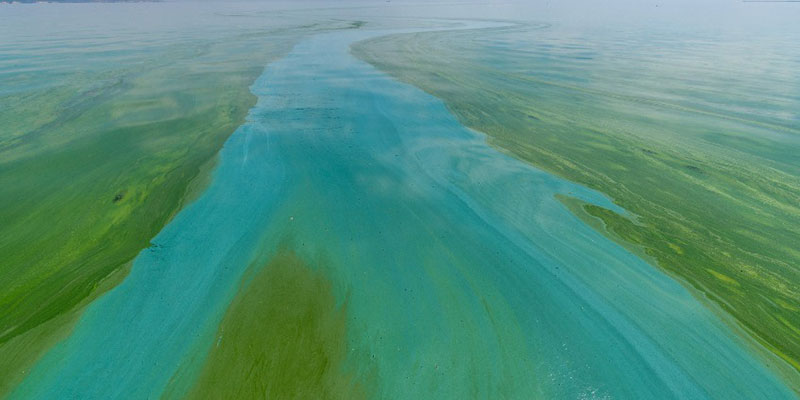Harmful algal blooms can introduce toxins into drinking water supplies.
Effective wastewater treatment can prevent overgrowth of the harmful algal blooms that release the toxins
Blue-green algae are single-celled photosynthesizing bacteria, known as cyanobacteria, that are found in both fresh water and marine ecosystems all around the world. When sunlight and nutrients (nitrates and phosphates) are plentiful, they multiply rapidly, forming dense algal blooms that cover the surface of the water.
Some cyanobacteria contain cyanotoxins, which typically cause gastrointestinal upsets and skin rashes. Other strains contain toxins such as microcystin, which affects the liver, or neurotoxins that affect the nervous system and may cause neurodegenerative diseases such as Alzheimer’s disease, amyotrophic lateral sclerosis (ALS), and Parkinson’s disease.
A 2007 national survey conducted by the United States Environmental Protection Agency (EPA) detected microcystin in one out of every three lakes sampled. While harmful algal blooms (HABs) can form throughout the year, they are most common during the warmer summer months. Exposure to cyanotoxins in lakes poses a risk to wildlife, pets, and public health. When cyanotoxins get into drinking water sources they can disrupt the drinking water supply, something that happened four years ago in Salem, Oregon.
Identifying the Toxins and Their Sources
A new study conducted by scientists from Oregon State University used DNA sequencing and toxin analysis to identify the precise types of toxins produced by specific cyanobacterial organisms.
For the study, which was recently published in the scientific journal Harmful Algae, the researchers sampled cyanobacterial blooms from 10 lakes across the state, including the Detroit Reservoir, which supplies drinking water to 192,000 people in Salem, Oregon, and surrounding communities. Genetic analysis showed that the toxin-producing Dolichospermum cyanobacteria was responsible for HABs in four of the 10 lakes sampled. Toxin analysis confirmed that microcystin was present in Odell Lake, Junipers Reservoir, and Lake Billy Chinook.
In 2018, low concentrations of microcystin and cylindrospermopsin cyanotoxins were detected in Salem’s municipal tap water. Vulnerable people, particularly infants and pregnant women, were advised not to drink it.
Salem isn’t the only city whose drinking water supply has been compromised by HABs. In 2014, Toledo, Ohio, issued an advisory cautioning more than 400,000 residents not to drink tap water after a cyanobacteria bloom in Lake Erie entered the city’s water supply.
Prevention Is Better Than Cure
HABs can have devastating environmental, public health, and socioeconomic consequences. It can cost cities millions of dollars to protect their consumers from cyanotoxins: Salem invested $75 million in cyanotoxin defenses.
The good news is HABs can be prevented simply be removing one of the key ingredients necessary for them to thrive: food. Nutrient-rich wastewater is one of the main causes of algal blooms in aquatic systems. Treating wastewater properly and ensuring key nutrients such as nitrogen and phosphorus are removed before effluent is released into the environment deprives blue-green algae of the food source necessary for them to flourish.
Fluence offers several innovative advanced wastewater treatment solutions for removing nutrients from wastewater. For example, Fluence’s Aspiral™ modular plants, which use membrane aerated biofilm reactor (MABR) technology, can reduce nutrients to levels suitable for safely discharging into the environment. Alternatively, the treated wastewater can be recycled and reused to irrigate crops.
If existing wastewater treatment plants are not treating wastewater sufficiently, they can be upgraded with Fluence’s SUBRE, which uses towers of MABR units to improve the quality of wastewater effluent discharged into the environment. Contact Fluence to find out how we can help you reduce your impact on the environment while also saving costs.

